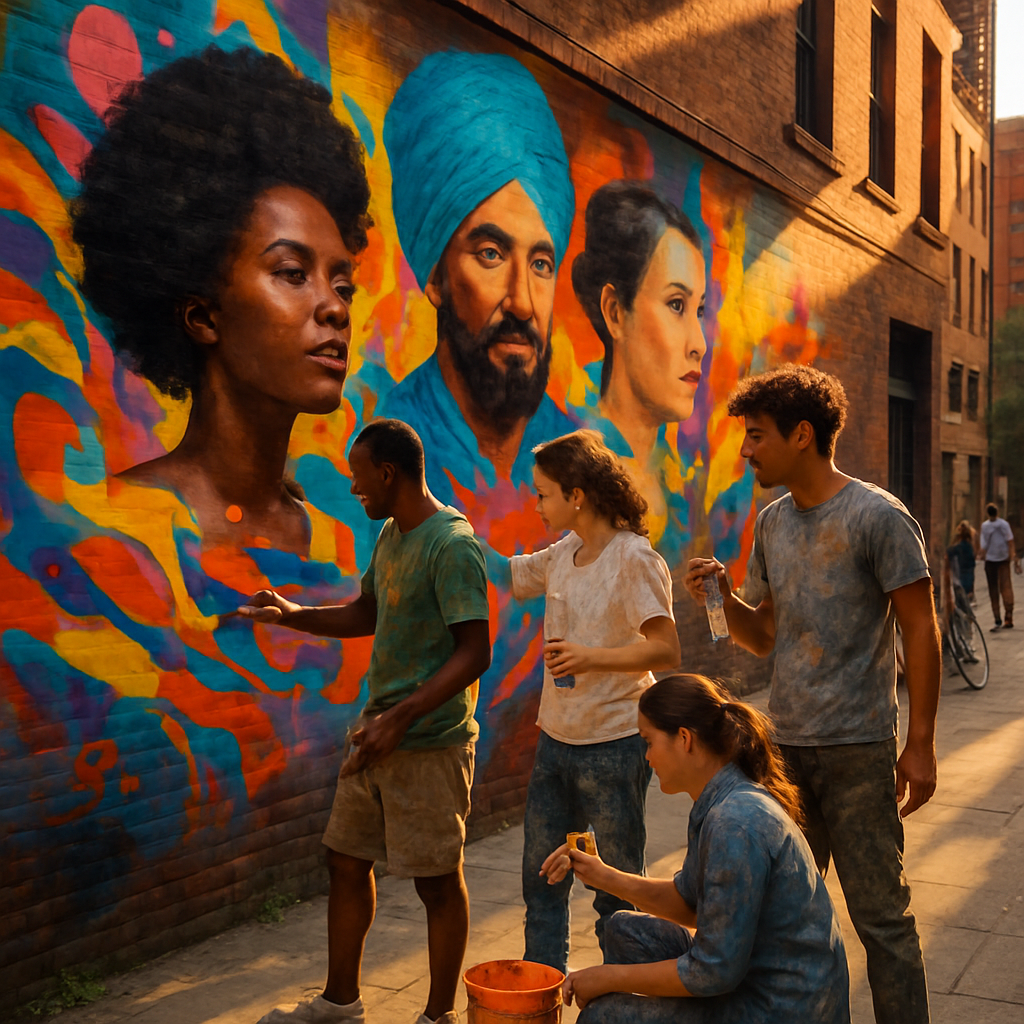The Evolution of Street Art From Vandalism to Cultural Expression

Once considered nothing more than criminal defacement, street art has undergone a remarkable transformation in public perception over the past few decades. What began as furtive tags sprayed under cover of darkness has blossomed into commissioned murals that define neighborhoods and attract tourists from around the globe. This shift represents more than just a change in artistic trends it reflects evolving attitudes about public space, expression, and what constitutes meaningful cultural contribution.
The walls of our cities have always served as canvases for those seeking to leave their mark. From prehistoric cave paintings to political slogans scrawled during revolutions, humans have an innate desire to communicate through visual means in shared spaces. Modern street art emerges from this ancient impulse but carries with it the complex baggage of property rights, class divisions, and questions about who gets to shape our visual environment.
From Underground Beginnings to Global Movement
The roots of contemporary street art trace back to Philadelphia in the late 1960s, where writers like Cornbread and Cool Earl began tagging their names across the city. The practice quickly spread to New York, where the competitive spirit of young artists in the Bronx and Brooklyn transformed simple signatures into increasingly elaborate styles. By the mid-1970s, subway cars became moving galleries of wildstyle lettering, characters, and scenes often painted under dangerous conditions in train yards at night.
These early practitioners weren’t thinking about art galleries or cultural legitimacy. Their motivations varied: some sought fame among peers, others wanted to rebel against authority, and many simply craved visibility in a society that overlooked them. “We couldn’t get our names in the newspaper or on TV unless we shot somebody,” explained PHASE 2, a pioneering graffiti artist. “But you could see your name all over town on a train.”
The authorities viewed this explosion of unsanctioned expression as nothing short of vandalism a symptom of urban decay and lawlessness. New York City spent millions on graffiti removal, with Mayor Ed Koch declaring war on the practice in the early 1980s. Transit police created specialized units to catch artists in the act, and new trains were coated with paint-resistant materials.
Yet even as officials fought to eradicate graffiti, the art world began to take notice. Galleries in SoHo and the East Village started exhibiting work by street artists like Jean-Michel Basquiat, Keith Haring, and Lee Quiñones. These crossover successes created a complicated dynamic within the street art community, with some artists eager to capitalize on mainstream interest while others viewed gallery shows as selling out.
The 1983 documentary “Style Wars” and books like “Subway Art” spread the aesthetic globally, inspiring new generations of artists from London to São Paulo. What had begun as a hyperlocal youth movement became an international visual language, with regional variations reflecting local cultures and concerns.
During the 1990s, street art began to diversify beyond spray paint and signatures. Artists like Shepard Fairey with his “Obey Giant” campaign and Banksy with his stenciled social commentary expanded what street art could be. Wheat-pasted posters, stickers, sculpture, and installation pieces joined traditional graffiti techniques. The focus shifted from simply getting your name up to communicating ideas and provoking thought.
This evolution coincided with broader changes in urban environments. As manufacturing declined in many Western cities, abandoned industrial zones became canvases for more ambitious works. Artists could spend hours on detailed pieces without fear of immediate arrest. Some neighborhoods, recognizing the potential cultural and economic benefits, began to tolerate or even encourage certain forms of street art.
By the early 2000s, the internet transformed how street art was created, shared, and consumed. Artists could document their ephemeral work and share it globally, building reputations far beyond their local scenes. Websites and social media platforms created virtual galleries that preserved pieces that might last only days or weeks in the physical world.
“The internet changed everything,” explains Roger Gastman, curator and graffiti historian. “Suddenly artists in Barcelona could see what was happening in Brooklyn or Melbourne almost instantly. Styles spread faster, and artists could build international followings without ever having a gallery show.”
The Institutionalization of Rebellion
The past fifteen years have witnessed street art’s remarkable journey from marginalized outlaw practice to mainstream cultural phenomenon. Banksy’s works sell for millions at auction. Wynwood Walls in Miami and the Houston Bowery Wall in New York offer sanctioned spaces for rotating murals by established street artists. Cities from Lodz, Poland to Valparaíso, Chile promote street art districts as tourist attractions.
Museums have embraced the form as well. The Museum of Contemporary Art in Los Angeles mounted “Art in the Streets” in 2011, the first major U.S. museum survey of graffiti and street art. Similar exhibitions have followed at prestigious institutions worldwide, cementing street art’s place in contemporary art history.
Corporate brands quickly recognized the marketing potential of street art’s authenticity and youth appeal. Companies from Nike to McDonald’s have commissioned street artists to create advertising campaigns, design products, and decorate stores. This commercialization has proven divisive within the community, raising questions about whether street art can maintain its countercultural edge while accepting corporate dollars.
The legal status of street art remains complicated. While cities increasingly commission murals and designate legal walls, unauthorized work continues to be criminalized in most places. This creates a strange dichotomy where the same artist might face arrest for painting one wall and receive payment for painting another.
This tension played out dramatically in 5Pointz, a former factory complex in Queens that had become a globally recognized graffiti mecca with the property owner’s initial permission. When the owner decided to demolish the buildings for condominiums in 2013, artists sued to protect their work under the Visual Artists Rights Act. Though they ultimately won a $6.75 million judgment, the artwork itself was destroyed highlighting the precarious existence of even celebrated street art.
The demographics of street art have also evolved. What began primarily as a male-dominated activity has seen increasing participation from women artists like Lady Pink, Swoon, and Faith47. The content has diversified as well, with many artists using their work to advocate for social justice, environmental causes, or community empowerment.
Brazilian artist Mundano exemplifies this approach with his “Pimp My Carroça” project, which transforms the carts of waste collectors with colorful art while advocating for better recognition and working conditions. Similarly, Palestinian artists use the Israeli separation wall as a canvas for expressions of resistance and calls for peace.
“Street art at its best has always been about reclaiming public space and giving voice to those who might otherwise go unheard,” says street art researcher Anna Waclawek. “That fundamental purpose remains, even as the acceptance and applications of the form have expanded.”
The COVID-19 pandemic sparked another wave of street art globally, with artists responding to the crisis through works honoring healthcare workers, criticizing government responses, or simply bringing color and hope to locked-down communities. These spontaneous expressions reminded many of street art’s unique ability to respond quickly to current events outside the constraints of traditional art world structures.
Street art’s journey from vandalism to valued cultural expression reflects broader social shifts in how we view authority, public space, and artistic legitimacy. The form’s evolution doesn’t represent a simple narrative of rebellion being co-opted by the mainstream, but rather a complex conversation about expression, ownership, and the purpose of art in our shared spaces.
As cities grapple with gentrification, tourism, and changing economies, street art often stands at the crossroads of these forces sometimes accelerating neighborhood change, sometimes resisting it, always commenting on it. The once-reviled practice now plays a central role in how many urban areas define and market themselves.
For the artists themselves, motivations remain as diverse as their styles. Some seek fame, others aim to beautify neglected spaces, many hope to provoke thought or action. What unites them is the desire to create outside traditional channels, to speak directly to the public without intermediaries.
The story of street art reminds us that cultural legitimacy isn’t fixed but constantly negotiated. Today’s vandalism might be tomorrow’s celebrated expression. The once-sharp line between high and low culture continues to blur, with street art serving as both a cause and effect of this change.
As we look to the future, street art will likely continue its dance between rebellion and acceptance, between spontaneous expression and planned installation. The tension between these poles generates much of the form’s energy and relevance. Perhaps street art’s greatest contribution is challenging us to question who has the right to shape our visual environment and what messages deserve space on our shared walls.


